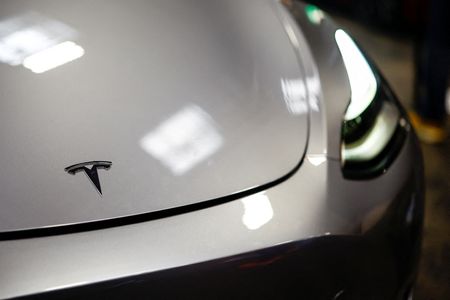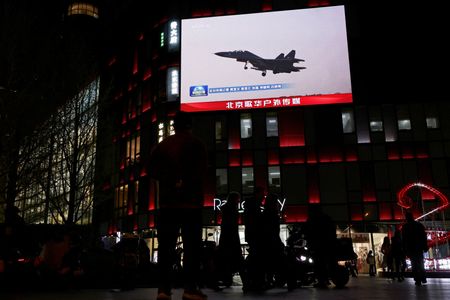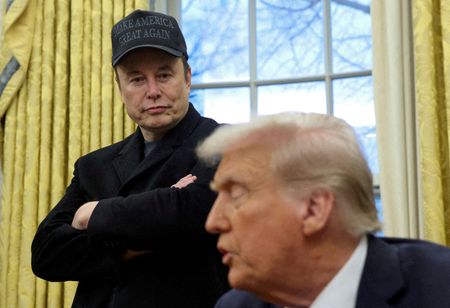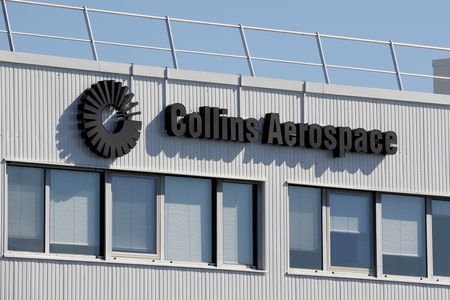By Gertrude Chavez-Dreyfuss
NEW YORK (Reuters) -Investors in financial derivatives called U.S. inflation swaps are betting that President Donald Trump’s tariffs will have a hefty short-term impact on consumer prices that will recede in the next few years as recession concerns escalate.
Inflation swaps are used to hedge against a rise in prices. They have two participants: the receiver and payer. The receiver seeks protection against rising inflation, while the payer, typically a bank, assumes the risk tied to inflation.
Specifically, the receiver agrees to exchange with the payer a fixed amount for floating payments tied to the Consumer Price Index (CPI) for a given notional amount and period of time.
These instruments are also used by market participants to speculate on the path of inflation and more broadly to infer inflation expectations. U.S. inflation swaps cleared by LCH have amounted to $1.3 trillion so far this year, having grown sharply since Trump’s January 20 inauguration in the face of rising tariff uncertainty.
Trump is expected to announce on Wednesday a wide range of reciprocal tariffs against U.S. trading partners who levy tariffs against imports from the United States. While there are no specific details on which products will be affected, analysts expect that tariffs will be imposed on cars, semiconductors, lumber, and pharmaceuticals.
The U.S. president, however, said last week, he was open to negotiating deals with countries seeking to avoid U.S. tariffs.
Ahead of this tariff announcement, U.S. one-year inflation swaps surged to a two-year high of 3.07% on Friday, and were last at 2.99% on Tuesday. This move means that investors believe headline CPI will average about 3% over the next 12 months, higher than the 2.8% year-on-year CPI reading for February, the latest available data.
U.S. two-year swaps, on the other hand, were at 2.84%, while those on three-year maturities stood at 2.42%, LSEG data showed, suggesting the market thinks inflation will come down after that initial spike.
“There’s an initial, one-time increase in inflation at the price level because firms have to raise prices to offset the impact of tariffs,” said Ryan Swift, chief bond strategist at BCA Research.
“But over the medium term, tariffs would actually slow manufacturing activity, which means less demand … and inflation will end up lower than what it would have been otherwise just because the economy is hurt. It reflects recession expectations.”
Recession is not the base case for many banks, although that likelihood has increased.
Goldman Sachs, in its latest research note, has raised its 12-month recession probability to 35% from 20%, reflecting its lower growth forecast for the fourth quarter, declining consumer confidence, and “statements from White House officials indicating willingness to tolerate economic pain.”
J.P. Morgan estimates a 40% chance of a recession.
BREAKEVEN INFLATION
There’s another measure of price increase expectations, however, called breakeven inflation, derived from the Treasury Inflation-Protected Securities market. Breakeven inflation and inflation swaps are similar, although the former has a liquidity premium attached to it due to supply and demand factors in TIPS trading.
Some analysts prefer to look at inflation swaps to measure expectations because they are not tied to liquidity issues.
Breakevens showed a similar pattern with U.S. inflation swaps: a big tariff impact in one-year breakevens of 3.4% on Tuesday, sliding in the next few years.
Some analysts pointed out that lower inflation expectations after that initial tariff-related rise seemed misplaced.
“If growth continues to chug along even if it is at a more subdued pace and you get this big supply shock coming from tariffs, the inflation impact in the near term will be larger than what the market is currently priced for and that could last longer,” said Phoebe White, head of U.S. inflation market strategy at J.P. Morgan.
She further noted that based on what the Trump administration has done so far, the tariff announcement on Wednesday may not be the last and incoming duties could affect other sectors of the economy.
“What we have seen since the inauguration are these rolling tariffs … I wouldn’t be surprised if we continue to get that kind of dynamic,” White said. “There could be this staggered effect where it could be hitting different parts of the CPI basket.”
Citi rates strategist Raghav Datla, on the other hand, noted that inflation pricing from tariffs would likely be gradual, adding that the market seems to be “taking a wait-and-see approach.”
Since the Trump administration’s March 26 announcement of 25% tariffs on auto imports, inflation expectations for the next 12 months, as measured by the one-year U.S. inflation swap rate, have gained just 13 basis points, which analysts view as a muted response to a large tariff.
“There’s a reason to be concerned that inflation remains somewhat elevated,” said George Bory, chief investment strategist for fixed income at Allspring Global Investments. “These are fairly sizable tariffs … and they’re broad-based and expected to touch many sensitive parts of the economy.”
(Reporting by Gertrude Chavez-Dreyfuss; Editing by Alden Bentley and Paul Simao)










